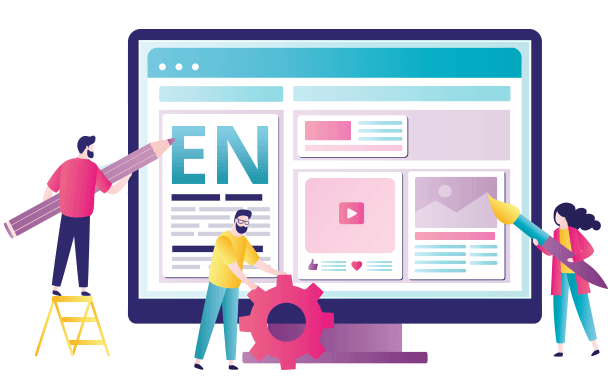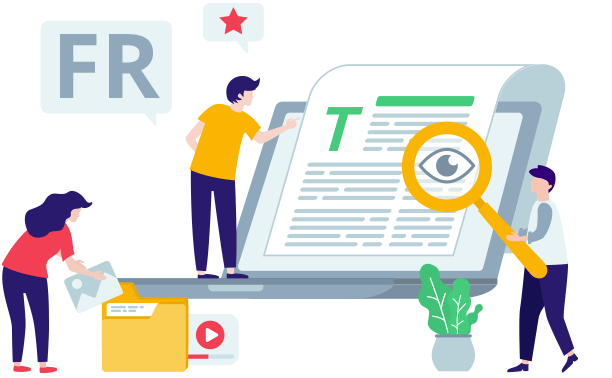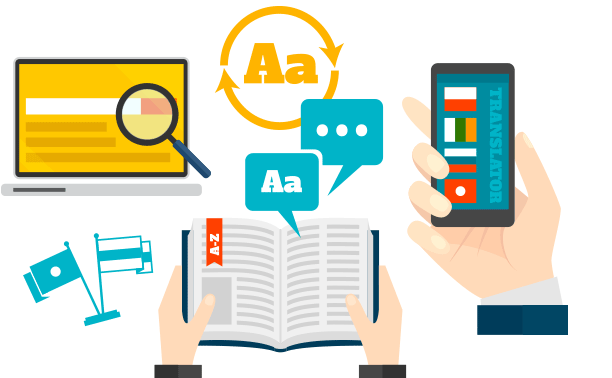As society increasingly acknowledges the many forms of diversity that exist, it’s understandable that language and communications are changing to reflect this. Inclusive writing is one of the most significant changes that we’ve seen over the last few decades, and it’s becoming more widespread in several parts of the world, particularly in Canada. That’s why it’s now an essential consideration for businesses.
Inclusive writing is a way of showing the value of the many types of diversity that occur in society. One aspect of this is the representation of gender diversity, a reality that is becoming more widely understood and recognized. The aim is to communicate in a way that is free of negative judgments or stereotypes—whether obvious or implied—of individuals or groups of people. Such negative perceptions are sometimes expressed by underrepresenting or overlooking many gender identities, which has been a common practice for a very long time. Inclusive writing demonstrates a growing willingness to have equitable and positive representation of various identities.
In this blog post, we’ll present a quick backgrounder and the main considerations for inclusive writing. We’ll then address why businesses should be interested in representing gender diversity in their communications. We also offer a strategy for those taking their first steps, to help them effectively adapt communications based on their goals and values. This article is not intended to be an exhaustive guide for inclusive writing, which is why we’ve also provided links to a series of practical tools.
Part 1 – Background and main considerations
An important consideration for businesses
Specific challenges based on language and culture
From feminization to increased neutrality
Summary of primary approaches currently used in English
Summary of primary approaches currently used in French
Part 2 – Implementation in business communications
Three key steps for adopting inclusive writing
Translation and inclusive writing
How Versacom can help you

Part 1 – Background and main considerations
An important consideration for businesses
More and more, businesses today are expected to take a stance on inclusive writing. It certainly is a key issue through which they can define themselves as commercial entities and corporate citizens. In societies where gender diversity is valued, a greater number of clients are choosing vendors who demonstrate a willingness to be inclusive in their communications. Not only does inclusive writing allow businesses to convey their values internally and externally, it can also set them apart from competitors who are less sensitive to diversity‑related matters.
That said, a shift toward inclusive writing can’t happen overnight, as a lot of existing content needs to be modified. Thought also needs to be given to the best way of creating new content and to the challenges associated with multilingual translation.

Specific challenges based on language and culture
Inclusive writing isn’t just a matter of linguistics. It requires thinking differently, questioning certain prejudices or stereotypes and acknowledging unconscious biases. Still, while language isn’t the only factor, it’s one essential way to offer representation of gender diversity. The tricky part is that not every language easily lends itself to this practice.
In languages that are considered to be grammatically genderless (Mandarin, Japanese, Hungarian, Finnish and Turkish, for example), masculine and feminine forms of articles and pronouns don’t exist. In so-called neutral languages, like English, most common nouns are neither feminine nor masculine (such as “teacher” or “president”). However, in grammatically gendered languages (French, Portuguese, Spanish, Italian, Romanian, Arabic and Hebrew, for example), inclusive writing is clearly a greater challenge. In these languages, almost everything needs to be masculine or feminine: nouns, pronouns, adjectives and more. In French, there is also the rule of generic masculine, meaning the masculine is used to represent both men and women. More and more people are challenging this rule, which dates back to the 17th century, and calling for more inclusive alternatives.
So, what’s the takeaway? The more a language is grammatically gendered, the more of a challenge it is to move toward inclusive writing that represents all gender identities, beyond the gender binary of male and female. Furthermore, in addition to strictly linguistic particularities, cultural considerations shouldn’t be overlooked. Depending on the country, region and social group, the importance given to and acceptance of inclusive language may vary greatly. In this article, we’re focusing primarily on representation of gender diversity in English and French, and mainly in North America.

From feminization to increased neutrality
Inclusive writing largely emerged out of the feminist movements in the 1970s and ’80s. This was more evident in French than in English because French is more gendered to begin with. But what changes took place, exactly? Essentially, many jobs previously open only to men became available to women; however, since feminine forms of the job titles didn’t exist, they needed to be created. Written communications also had to account for the greater presence of women in the workplace. Feminization—or consistently using both the feminine and the masculine forms—was thus one of the first forms of inclusive writing to represent gender diversity.
In the decades that followed, this movement toward inclusion evolved into an approach that favours neutrality, both in English and in French. Increased neutrality means creating texts that are less gendered by avoiding masculine and feminine grammatical markers as much as possible. Why is this important? For one thing, this approach allows for representation of many of the other gender identities that exist. As a bonus, by not using both the feminine and the masculine forms, texts can be lighter.
While a greater number of expressions of gender identity are used today, the breadth of opinions on this has grown as well. As a result, different inclusive writing approaches have emerged. We’ve summarized the primary approaches currently used in English and in French. It’s important for each business to understand and choose the approach that aligns with its values and goals.

Summary of primary approaches currently used in English
Generally speaking, a more neutral writing style showed up earlier in English, probably because the language is more conducive to it than French or some other languages. Here are three of the main strategies English writers use to achieve increased neutrality.
Principle
Example of gendered wording
Example of neutral wording
Using neutral nouns to avoid gendered pronouns
He/she will be assigned to groups.
The candidate will be assigned to groups.
Replacing a gendered singular pronoun with a plural noun or pronoun
He/she will arrive later today.
They will arrive later today.
Using they to refer to one person
Every individual is unique. He/she is a combination of strengths and weaknesses.
Every individual is unique. They are a combination of strengths and weaknesses.
Principle
Utiliser des substantifs neutres pour éviter les pronoms genrés
Example of gendered wording
He/she will be assigned to groups.
Example of neutral wording
The candidate will be assigned to groups.
Principle
Using neutral nouns to avoid gendered pronouns
Example of gendered wording
He/she will arrive later today.
Example of neutral wording
They will arrive later today.
Principle
Using they to refer to one person
Example of gendered wording
Every individual is unique. He/she is a combination of strengths and weaknesses.
Example of neutral wording
Every individual is unique. They are a combination of strengths and weaknesses.
The idea behind this isn’t to just randomly insert neutral terms or expressions. Rather, if you use a wider variety of expressions and write an entire text with inclusivity in mind, the text will seem more natural and authentic. Each type of content, and even each sentence, has its own challenges and requires its own creatively tailored solutions. With content of a legal nature, for example, some consider it problematic or confusing to replace “he or she” with “they,” as it may become unclear if the text is referring to an individual or a group. You’ll find clarifications around this and other situations in our recommended resources.
NON-BINARY AND GENDER-INCLUSIVE WRITING
Another approach, advocated by gender-diverse people and their allies, includes using a personal pronoun that matches their gender identity or expression. This pronoun may not be reflected among the man-woman (gender) or male-female (sex) binary. Some of the gender-diverse identities include:
- People who don’t identify with the gender associated with the sex assigned to them at birth (transgender persons)
- People who don’t identify with any gender identity (agender persons)
- People who identify as having two genders (bigender persons)
- People whose gender identity is partially associated with a specific gender (demigender persons)
- People whose gender identity or expression changes over time (genderfluid persons).
While this may seem like a personal choice to some, and an official list of accepted terms or neopronouns (such as “ze,” “xie” and “hir”) doesn’t yet exist or is still (and always) evolving, there are recommendations and solutions to be considered.
The first is to avoid assuming or referring to an individual’s gender when communicating with them. This applies especially when choosing a salutation or courtesy title in written correspondence. In addition, if your business does choose to ask for an individual’s pronouns or title, you need to ensure they are used in your writing.
Principle
Example of gendered wording
Example of non-binary or gender-inclusive wording
Avoiding gendered titles, salutations and expressions
Dear Ms. Terry Smith:
Dear Terry Smith:
Using an individual’s preferred courtesy title
Dear Pat Cicolo,
Dear Mx. Pat Cicolo,
Omitting any reference to an individual’s gender
Mr. Jong Yu has been a valued member of our team since 1997.
Jong Yu has been a valued member of our team since 1997.
Principle
Avoiding gendered titles, salutations and expressions
Example of gendered wording
Dear Ms. Terry Smith:
Example of non-binary or gender-inclusive wording
Dear Terry Smith:
Principle
Using an individual’s preferred courtesy title
Example of gendered wording
Dear Pat Cicolo,
Exemple de nouvelle formule
Dear Mx. Pat Cicolo,
Principle
Omitting any reference to an individual’s gender
Example of gendered wording
Mr. Jong Yu has been a valued member of our team since 1997.
Example of non-binary or gender-inclusive wording
Jong Yu has been a valued member of our team since 1997.
People in charge of business communications, writers, editors and translators all have good reason to closely monitor the ways that English and other languages are evolving to become more inclusive. It’s important to be aware of non-binary and gender-inclusive writing, to understand it, and to know how to use it based on the organization’s target clients, values and stance.
Useful resources and practical guides
- Guidelines for gender-inclusive writing in English (Government of Canada)
- Inclusionary: A collection of gender-inclusive solutions (Government of Canada)
- Gender-inclusive writing: correspondence (Government of Canada)
- Legistics – Gender-neutral language (Government of Canada)
- Gender and sexual diversity glossaries (Government of Canada)
- UN Women searchable gender-inclusive lexicon (UN Women)
- Affirming and Inclusive Language (Egale Canada)
- Pronoun Usage Guide (Egale Canada)
- LGBTQI2S Terms and Concepts (Egale Canada)
- Gender Diversity in Legal Writing (British Columbia Law Institute)
- Glossary of Terms – A Reference Tool (Canadian Centre for Diversity and Inclusion)
- LGBTQ2S+ inclusion – Educational Resources (Canadian Centre for Diversity and Inclusion)
- Lexic (Fondation Émergence)
- Inclusive Language: How to Use it & Why It Matters (It Gets Better Canada)
- How to Make Your Organization’s Language More Inclusive (Harvard Business Review)

Summary of primary approaches currently used in French
As French is a highly gendered language, it does present particular challenges that don’t exist in English when shifting to a neutral and inclusive style. For this reason, there are various approaches, and not all of them are equally accepted.
Two main approaches are used in Canada:
1. Epicene writing
This approach is the most commonly used and creates representation of gender diversity by focusing on the existing rules and resources in French. If a term or expression to designate a new reality doesn’t exist, a new one can be created as has been done for centuries. You need only look at the list of words added to dictionaries every year to see proof of this. However, with epicene writing, the aim is to change the language as little as possible. This can be achieved by favouring what already exists and what can be reused to meet new needs such as creating more gender-neutral content.
2. Non-binary writing
As is the case in English, this approach is favoured by some to designate or represent non-binary individuals. Non-binary writing uses neutral formulations the same way that epicene writing does (details below), but goes further by advocating for more proactive and bold innovation when existing resources in French are deemed insufficient.
EPICENE WRITING
This approach involves several techniques and solutions, including the following three.
Principle
Example of gendered wording
Example of inclusive wording
Using neutral wording, made up of terms and expressions without gender markers
généreux (masculine) or généreuse (feminine)
charitable (both masculine and feminine)
Using the feminine form as well as the masculine form
les lecteurs (generic masculine)
les lectrices (feminine) et les lecteurs (masculine)
Using abbreviated doublets
l’autorisation du directeur
la signature du sauveteur
l’œuvre de l’auteur
l’autorisation du (de la) directeur( trice)
la signature du [de la] sauveteur[-euse]
l’œuvre de l’auteur·e
Principle
Using neutral wording, made up of terms and expressions without gender markers
Example of gendered wording
généreux (masculine) or généreuse (feminine)
Example of inclusive wording
charitable (both masculine and feminine)
Principle
Using the feminine form as well as the masculine form
Example of gendered wording
les lecteurs (generic masculine)
Example of inclusive wording
les lectrices (feminine) et les lecteurs (masculine)
Principle
Using abbreviated doublets
Example of gendered wording
l’autorisation du directeur
la signature du sauveteur
l’œuvre de l’auteur
Example of inclusive wording
l’autorisation du (de la) directeur(‑trice)
la signature du [de la] sauveteur[-euse]
l’œuvre de l’auteur·e
The importance of variety in epicene writing
Just like in English, the goal of epicene writing is to produce meaningful and appealing content. This isn’t possible if we just mechanically insert certain words or inclusive expressions without second thought, or approach this as a one-size-fits-all solution. Content is more effective when you switch up techniques. Inclusive writing guides offer an abundance of very creative and practical solutions for you to discover and use.
One thing that doesn’t change from traditional writing to inclusive writing is the need to adapt techniques to the type of content. For example, abbreviated doublets might make more sense in content with limited space (tables and forms, for example). For content that is going to be spoken aloud, such as a speech, using both the feminine and masculine forms may not make any difference. For example, the feminine form “employées” and the masculine “employés” are pronounced the exact same way, so people may get the impression you’re just repeating the word.
NON-BINARY WRITING
What this approach has in common with epicene writing is the use of neutral wording, meaning terms or expressions that don’t have gender markers (as demonstrated in the table above).
Non-binary writing differs in that it involves the creation and accepted use of neologisms to specifically represent non-binary and gender-diverse people, for example:
- The pronoun “iel” to replace “il ou elle”
- The noun “frœur” instead of “frère ou sœur”
- The adjective “heureuxe” to replace “heureux ou heureuse”
For now, organizations such as the Office québécois de la langue française (OQLF) don’t recommend this approach. The OQLF prescribes using epicene writing as it allows for resources that already exist in French to be used to meet new needs.
Nevertheless, non-binary writing is gaining importance and visibility. For example, the pronoun “iel” was added to the online version of the French dictionary Le Robert in 2021. Despite this creating controversy, it shows the linguistic push for the representation of non-binary and gender-diverse people—and a level of care—by respecting the language they use.
Useful resources and practical guides
Office québécois de la langue française
- The Vitrine linguistique has more than 70 articles on key topics, including:
Principes généraux de la rédaction épicène
Qu’est-ce que la formulation neutre?
Noms épicènes
Pronoms épicènes
Adjectifs épicènes
Phrases épicènes
Appellations de personnes épicènes
Liste de termes épicènes ou neutres
Désigner les personnes non binaires
Allègement du texte en rédaction épicène
Government of Canada
- The Écriture inclusive – Lignes directrices et ressources found on the Language Portal of Canada provides access to extremely useful and current articles, glossaries and resources on inclusive writing in various contexts.
- L’Inclusionnaire presents gendered words to designate or describe people and offers inclusive solutions for replacing them.
Other important resources
- Ressources en ligne d’ONU Femmes sur l’utilisation du langage inclusif (UN Women, includes a searchable multilingual glossary)
- Grammaire de genre neutre et langage inclusif (Egale Canada)
- Egale French Style Guide (Egale Canada)
- Termes et concepts 2SLBGTQI (Egale Canada)
- Glossaire des termes – Un outil de référence (Canadian Centre for Diversity and Inclusion)
- Lexique (Fondation Émergence)

Part 2 – Implementation in business communications
Three key steps for adopting inclusive writing
Inclusive writing requires that decision-makers first consider the overarching stance or the approach your organization will take around inclusivity. This decision is closely tied to your mission and vision, and even to your business objectives. It’s an exercise that will help you build a plan with clear priorities, as inclusive writing is not something that happens overnight.
Some businesses begin by using more inclusive writing in their human resources communications, with job postings sometimes at the top of this list. Inclusive internal and external job postings can help you generate the largest pool of qualified candidates, and ultimately foster a more inclusive workplace.
That being said, each business needs to decide where to start and what its priorities are. The following three steps can help with that process.
Step 1: Analysis
Here are some basic questions to ask to get a clear picture of your organization’s situation:
- What are your mission and vision?
- What are your communication objectives?
- What are your values and, more specifically, your position on inclusion?
- What are your target markets and clienteles?
- Are gender-diverse communities strongly represented within or a particular focus for any of your target markets or clienteles?
- What are the advantages of adopting inclusive writing and the disadvantages of not doing so?
- Do you have the information needed to answer these questions or should you conduct research or surveys?
Based on the information you gather and analyze, you should be able to recommend an overall approach to the company’s senior managers and then fine-tune it based on their valuable insights. Above all, you will secure the high-level support you need to move on to the next step.
Step 2: Planning
Here are some of the major decisions that need to be made to map out a detailed approach, factoring in the important considerations, steps and processes for successful implementation:
- Which internal and external partners—existing or new—will you bring on board? Are any individuals part of gender-diverse communities? Don’t forget to include your communications or translation agencies.
- Which inclusive writing approach will you select for each language and why?
- Which existing content must/can be modified or completely replaced?
- Which multilingual content also requires inclusive translation?
- How are you going to create new content going forward?
- What will the order of priority and timeline for revision, replacement, translation or creation be, step by step?
- What would the budget look like for each part of your implementation?
- What metrics/KPIs are you going to use to monitor the positive impact of more inclusive communications?
Your planning should result in a detailed action plan, which, once approved by the company’s leadership, will ensure you have all the funding and resources for a successful implementation. It’s important to share your plan, or key parts of it, with your partners (including your translation agency) so they can fully support you throughout the project.
Step 3: Implementation
Here are some essential steps to take to successfully roll out your action plan:
- Select your internal and external partners, and organize the project team.
- Inform and train all partners based on their respective roles.
- Complete step 1 of the action plan, ideally as a small-scale pilot project.
- Implement the plan’s subsequent steps based on your timeline, priorities and the actions you intend to take.
- Assess results after each step, based on the metrics chosen.
- Provide stakeholders with regular progress reports and results.
- Update the action plan as needed.
Keep in mind that adopting inclusive writing isn’t a one-and-done project with a set deadline: it’s a long-term transformation, an ongoing process. Best practices are certainly going to evolve over time, as will societal and individual values. The more integral inclusive writing becomes to your everyday communication practices, the easier it will be for your business to carefully reflect and adapt as things change.

Translation and inclusive writing
Your inclusive content may need to be translated from a less grammatically gendered language to one that is more gendered, or vice versa.
For example, even if your content is very inclusive in English, there are still fundamental considerations for translating it into French. Lots of expressions and ways of wording things are neutral in English, but their French translation might not be. As a result, translators are often faced with decisions about how to ensure the French text is equally neutral and inclusive. To make the right choices, they need to understand your approach to inclusive writing and your rationale.
A professional translation agency can be one of your valuable partners from the planning stage through to the creation of your action plan for inclusive translation. The earlier your agency is involved in the process, the better they can help you ask the right questions and figure out the answers so you avoid delays at the implementation stage.
Here are some basic questions to discuss with your agency:
- What is your preferred inclusive writing approach?
- Are you aiming for the highest possible level of neutrality, without feminine or masculine markers?
- Do you want to use non-binary and gender-inclusive writing, and, if so, for which content and in which situations?
- If they’re uncertain, who should your translators turn to or where should they look for guidance?

How Versacom can help you
A number of gender-diverse communities are represented within Versacom’s team, and for several years now, we’ve been involved in creating increasingly inclusive multilingual content.
We actively and continuously reflect on this matter, not only for our clients’ content, but for our own as well. Consequently, we regularly carry out research to stay up to date on how the approaches and schools of thought are evolving, and can help our client organizations assess their situation and the possible approaches for different languages.
What Versacom offers
- Support with the analysis, planning and implementation of your inclusive writing strategy
- Assessment and revision of existing original or translated content
- Inclusive translation and terminology services for new content
Versacom’s advisors can provide you with ad-hoc support or join your inclusive writing task force. Request a free consultation to learn more and get answers to your questions.

